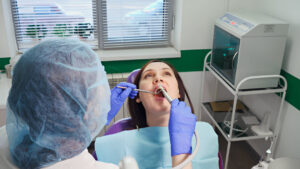Over time, orthodontic treatment has advanced dramatically, giving people more alternatives for getting a straighter, more aligned smile. We will summarize braces and Invisalign in this blog post, laying the groundwork for a thorough comparison based on several factors.
This blog’s main goal is to compare Invisalign and traditional braces in-depth while considering various variables that affect people’s treatment decisions or is Invisalign better than braces. Through analyzing factors including maintenance, treatment time, effectiveness, comfort, and aesthetics, our goal is to empower readers to make well-informed choices about which orthodontic solution best suits their needs and lifestyle.
Brief Overview of Invisalign and Traditional Braces
Using a series of clear, removable aligners, Invisalign is a cutting-edge orthodontic procedure that gradually realigns teeth whitening to their ideal positions. Custom-made for every patient, these aligners provide a subtle and adaptable substitute for traditional braces.
Conventional Braces: In contrast, traditional braces are made of ceramic or metal brackets affixed to the teeth, joined by wires, and fastened with bands. Over time, this fixed appliance will move teeth into perfect alignment by applying constant pressure.
Understanding Invisalign and Traditional Braces
What Is Invisalign?
Description of Invisalign technology.
Invisalign is a revolutionary orthodontic procedure that corrects misaligned teeth using state-of-the-art technology. A series of clear aligners that are custom-made and intended to move teeth into the correct position progressively are used in this treatment.
How Invisalign works.
How Invisalign Works: The systematic approach to treatment is the foundation of Invisalign. Each pair of aligners that patients get is worn for roughly two weeks before moving on to the next set. Over time, the aligners move some teeth into alignment by applying mild, controlled force.
What are Traditional Braces?
Description of traditional braces technology.
The technology behind traditional braces has been a mainstay in orthodontic therapy for many years. They are made out of brackets that are cemented to the teeth, either metal or ceramic. The wires that link these brackets are frequently changed to exert pressure on the teeth.
How braces work.
Braces Operate Traditional braces work by applying constant pressure to the teeth to push them into the proper position. To maintain the proper force, orthodontic practitioners must tighten the wires regularly. Traditional braces offer a constant and dependable way to address biting problems and complex misalignments despite not being removable.
Aesthetic Considerations
Visibility
Comparison of the visual appearance of Invisalign and braces.
For many people considering orthodontic treatment, the visibility of the corrective appliances is critical. With its transparent aligners, Invisalign provides a practically undetectable solution. Because the aligners are translucent, they discreetly match the color of teeth, offering a less obvious choice to people who would rather not be as noticeable.
Social and Psychological Impact
Discussing how each option impacts social interactions and self-esteem.)
Choosing between Invisalign and conventional braces can have psychological and social repercussions. The inconspicuous look of Invisalign frequently reduces the self-consciousness of having braces on display. Patients may feel more comfortable during these times because the aligners hardly show in photos or social situations.
Effectiveness and Treatment Scope
Types of Dental Issues Addressed
The effectiveness and treatment breadth of traditional braces and Invisalign are important considerations for orthodontic treatment. Every approach has advantages and is better suited to treat particular dental bridge problems.
Invisalign: For mild to moderate orthodontic problems, Invisalign is quite successful. This comprises:
- Gaps Between Teeth: Minor to moderate gaps between teeth can be successfully closed using Invisalign.
- Overcrowding: It is an appropriate treatment for mild to moderate cases of tooth overcrowding.
Conventional Braces: Due to their all-encompassing nature, conventional braces can treat a wider variety of tooth problems, such as:
- Severe Misalignments: Traditional braces can effectively treat More severe tooth misalignments.
- Complex Bite disorders: They are capable of successfully fixing major overbites, underbites, and crossbites, among other complex bite disorders.
Comparing the range of dental issues each can effectively treat.
When evaluating the variety of dental porcelain veneers problems, Invisalign is best suited for people looking for a discrete fix for mild to moderate disorders that prioritize flexibility and aesthetics. Due to their versatility, traditional braces are more appropriate for people who value a thorough and efficient treatment plan and have significant misalignments or complex orthodontic disorders.
Treatment Duration
The length of treatment is a crucial consideration for people deciding between Invisalign and traditional braces. The length of time it takes to get a straighter smile might greatly impact how decisions are made.
Average treatment time for Invisalign vs. braces.
Invisalign: Compared to traditional braces, Invisalign is frequently associated with a comparatively shorter treatment period. The usual duration of an Invisalign treatment is 12 to 18 months.
Conventional Braces: Compared to Invisalign, traditional braces usually require a lengthier treatment period. Braces require an average of 18 to 36 months of treatment.
Comfort and Convenience
Physical Comfort
Discussing the comfort level during treatment with Invisalign vs. braces.
Invisalign: The smooth, pleasant materials used to create bespoke aligners for Invisalign minimize gum and cheek irritation. Oral sores and discomfort are less likely when no metal wires or brackets exist.
Conventional Braces: Although improvements in orthodontic technology have produced more pleasant styles, the mouth must first become accustomed to the sensation of brackets and wires in traditional braces, which can be uncomfortable at first.
Lifestyle Adjustments
The necessity of dietary adjustments, how simple cleaning is, etc.
Invisalign: The little influence of Invisalign on eating habits is one of its noteworthy benefits. Patients can eat whatever they want during treatment because the aligners are removable.
Conventional Braces: Certain dietary modifications may be necessary to prevent food from getting stuck in the braces or breaking them. Some foods, such as hard candies and sticky delicacies, should be avoided to save brackets and wires from getting damaged.
The need for dietary changes, ease of cleaning, etc.
Because of its smooth, detachable aligners, Invisalign frequently offers a more comfortable experience when it comes to comfort and convenience. The better alternative depends on several factors, including lifestyle concerns, orthodontic case complexity, and personal preferences.
Cost Comparison Between Braces and Invisalign
Initial Costs
Invisalign: Several variables, including the case’s complexity, treatment length, and geographic location, may affect the initial expenses of Invisalign treatment. Compared to traditional braces, Invisalign often has a higher initial cost.
Conventional Braces: Compared to Invisalign, traditional braces typically have a cheap teeth straightening cost. Brace more reasonably priced components include ceramic or metal wires and brackets.
Long-term Costs
Talking About Any Future Expenses, Including Upkeep:
Invisalign: If aligners are misplaced or broken, extra maintenance expenses may be associated with Invisalign. The total cost of treatment includes getting new aligners at each stage of the procedure and routine checkups.
Conventional Braces: The long-term expenses of traditional braces include possible emergency appointments for problems like broken brackets or protruding wires and regular adjustments.
Pros and Cons
Advantages of Invisalign
1. Aesthetics: For patients who place a high value on aesthetics throughout treatment, Invisalign’s clear aligners provide a discrete and almost invisible teeth straightening alternative.
2. Comfort: The smooth, bespoke aligners reduce gum and cheek irritation, making the process more bearable.
Advantages of Traditional Braces
1. Versatility: Traditional braces work incredibly well to cure orthodontic disorders, such as severe misalignments and challenging bite abnormalities.
2. Predictable Outcomes: Because braces are fixed, precise control over tooth movement can lead to comprehensive and predictable outcomes.
Limitations of Each Option
For Invisalign:
1. Cost: Compared to traditional braces, Invisalign typically has a greater initial cost.
2. Not Adequate for Every Situation: If your child needs extensive tooth mobility or has complicated orthodontic issues, there might be better choices than Invisalign.
Customized Braces:
1. Aesthetics: Wearers of traditional braces may feel less confident in social or professional contexts since they are more noticeable.
2. Maintenance Difficulties: Cleaning around brackets and wires might be harder, necessitating more attention and specialized equipment.
Making the Right Choice
Factors to Consider
Several factors impact a person’s decision to select Invisalign over traditional braces. Think about the following:
1. Orthodontic Needs: One of the most important factors is how severe the orthodontic problems are. Invisalign works well for mild to moderate situations; conventional braces are a better option for more difficult situations.
2. Aesthetic Preferences: Those who value discretion in appearance might favor Invisalign, while people who don’t care as much about visibility might think about traditional braces.
3. Lifestyle & Convenience: People with hectic schedules may find Invisalign’s removable aligners convenient. Traditional braces could be a good option for people ready to commit to a set appliance.
Consultation with Orthodontics
The Value of Expert Counsel When Making Decisions:
Making an educated choice requires consulting with an orthodontic specialist. What orthodontists can offer is
1. Thorough Evaluation: Experts can evaluate the case’s intricacy and suggest the best action based on each patient’s demands.
2. Personalized Recommendations: When making recommendations, orthodontists consider several aspects, including age, lifestyle, and aesthetic preferences.
3. Cost Estimates: Experts can provide precise cost estimates that consider insurance coverage, possible payment plans, and both initial and ongoing expenses.
Conclusion:
The decision between Invisalign and traditional braces is a big one influenced by many factors in the quest for a straighter, more aligned smile. This thorough comparison has examined several factors, including treatment extent, cost, maintenance, comfort, and aesthetics. No one solution works for everyone when deciding between Invisalign and braces because each has unique benefits and drawbacks.
One of the most important things to do before deciding is to see an orthodontic expert for expert assistance. Experts can offer a comprehensive evaluation, tailored suggestions, and reasonable expectations. This guarantees that people approach orthodontics fairfield with confidence and the information they need to make the best decision for a more attractive, healthy smile.
Read our other blog and find out if dental implants are painful or not


